New Members
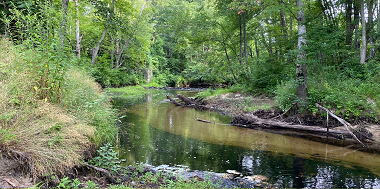
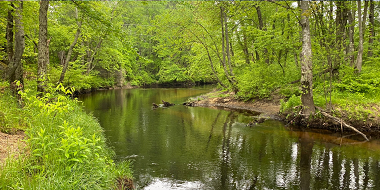
The Nashua River Watershed Association is pleased to share our 2022 Water Report. This new report analyzes the results of our 2022 water monitoring season covering topics such as: what do we study and why? what do the results tell us about the health of our waterways? what sections of rivers or streams are facing water quality challenges? The report is detailed and provides supporting images, graphs, and charts.
Thank you as always to our team of volunteer water monitors. In 2022, they collected 877 individual surface water samples. Their dedication makes our work to protect our waterways possible. This Report is dedicated to all of you.
Read the NRWA’s 2022 Water Report.
The 2022 Water Report in a nutshell.
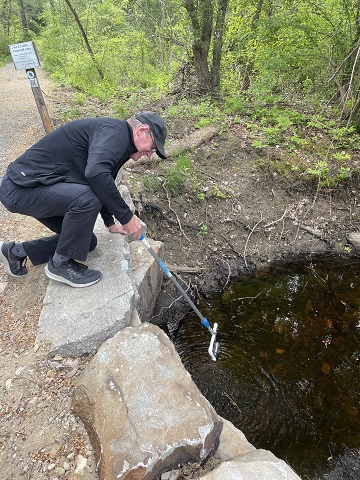 What do we study and why?
What do we study and why?
E. coli because this is a bacteria species that, when present in water at high levels, may cause illness making our waterways unsafe for recreation.
Dissolved oxygen (DO) because aquatic animals and plants need oxygen to survive. DO decreases as water warms. Higher DO levels usually indicate a healthy riverine ecosystem, and lower levels lead to degraded habitat.
Water temperature because it impacts the diversity of aquatic plant and animal life in our waterways. Warmer temperatures can reduce DO levels, increase salt concentrations, as well as toxicity of compounds such as insecticides.
Conductivity because this essentially indicates the concentration of salts (such as road salts) in the water which can negatively impact aquatic life.
What did we find in 2022?
Good news
> In general, our rivers and streams are safe for human recreation and provide favorable conditions for warm water adapted aquatic life.
> Dissolved oxygen was generally high in the North Nashua River (Fitchburg to Lancaster) and the Nashua Mainstem (Lancaster to Nashua).
> All of the water temperature readings met the warm water fishery standard, and five of ten state-listed coldwater fisheries were consistently cold enough to provide healthy cold water habitat.
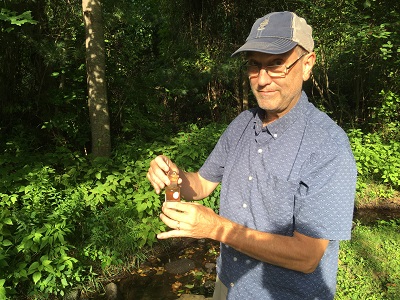 Challenges
Challenges
Climate Change: Our waterways are being impacted by rising temperatures, heavy rainfall, and drought conditions which are a result of our warming climate. Last summer’s drought strongly impacted the health of our waterways, leaving many headwater and tributary streams nearly dry. Low water levels led to faster warming of the water, lowered dissolved oxygen levels, and more concentrated pollutants negatively impacting fish, amphibians, and other aquatic life.
E. coli: NRWA identified hot spots where E. coli reaches unsafe levels after heavy rainfall events when rainwater overwhelms outdated municipal sewer systems causing an overflow discharge directly to the river (CSO- combined sewer overflow). Heavy rainfall also causes flash runoff over impervious surfaces washing pollutants into our waterways. All four hot spots were in the North Nashua River subwatershed in the heavily urban landscapes of Fitchburg and Leominster. The City of Fitchburg is actively working on eliminating CSOs in the City.
Dissolved oxygen: Streams impounded by dams can show lower DO levels, unsuitable for coldwater fish, and such was found on Mulpus Brook and the Squannacook River. Catecunemaug Brook in Shirley below the Lake Shirley Dam also had repeatedly low DO and is designated as impaired for DO and not supportive of aquatic life. The Nissitissit River in Brookline and Pepperell also had some low DO readings making it essential to continue tracking DO in this popular fly-fishing destination.
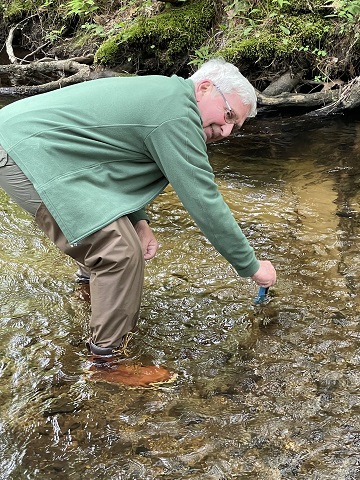 Temperature: Five waterways (Nissitissit and Squannacook Rivers; Willard, Mulpus and Catecunemaug Brooks) that are state-listed as a Coldwater Fish Resource had water temperature readings that were elevated, presenting a potential challenge to cold water dependent species.
Temperature: Five waterways (Nissitissit and Squannacook Rivers; Willard, Mulpus and Catecunemaug Brooks) that are state-listed as a Coldwater Fish Resource had water temperature readings that were elevated, presenting a potential challenge to cold water dependent species. Conductivity: Conductivity readings were elevated in the North Nashua River subwatershed in the summer months as low stream flows likely concentrated salts in the streams. Again, the urbanized nature of this subwatershed with extensive roads, parking lots, and impervious surfaces in close proximity to streams exposes waterways to stormwater runoff.
Funding for the NRWA’s 2022 water monitoring season was provided by Bemis Associates, Inc., Bristol Myers Squibb, MA Dept. of Environmental Protection, MA Division of Ecological Restoration, Fieldstone Foundation, Fleetwing Charitable Foundation Trust, Greater Lowell Community Foundation, and Nypro Inc.
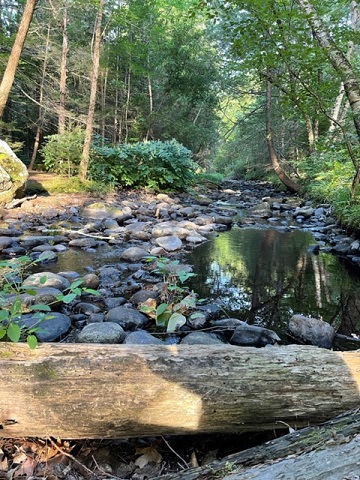
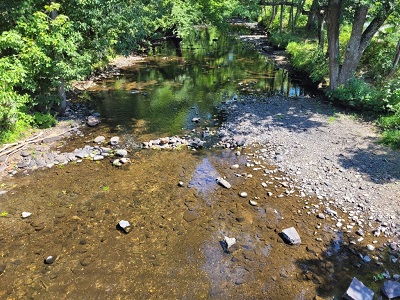
Images top to bottom
Banner images: Left- The Squannacook River in Townsend, MA in July of 2022 showing low water levels that continued throughout the summer and early fall due to the critical drought. Right- The Squannacook River in Townsend, MA in June of 2022 before impacts of drought. Photos by Rob Templeton
Photo 1: A volunteer uses a telescoping pole to reach James Brook in Groton, MA for an E. coli water sample. Photo by Janet Sheffield
Photo 2: Pete Steeves collecting a dissolved oxygen sample from Reedy Meadow Brook in Pepperell, MA in August 2022. Pete was a volunteer water quality monitor for the NRWA for 18 years before retiring from the program last year. Thank you for your dedication Pete! Photo by Max McCormick
Photo 3: A volunteer tests temperature and conductivity at Flint Brook in Hollis, NH. Flint Brook is a coldwater fishery that drains directly into the Nashua River. Photo by Denise White
Footer images: Left- Low water conditions in Willard Brook just upstream from Damon Pond in Ashby, MA in mid-August 2022. Willard Brook is a coldwater fishery which feeds the Squannacook River. Photo by Barbara Fox Miles Right- Low water conditions in the Nissitissit River near Mill Street in Pepperell, MA in mid-August 2022. The Nissitissit River is a coldwater fish resource and a significant tributary to the Nashua River. Photo by Nan Quintin

